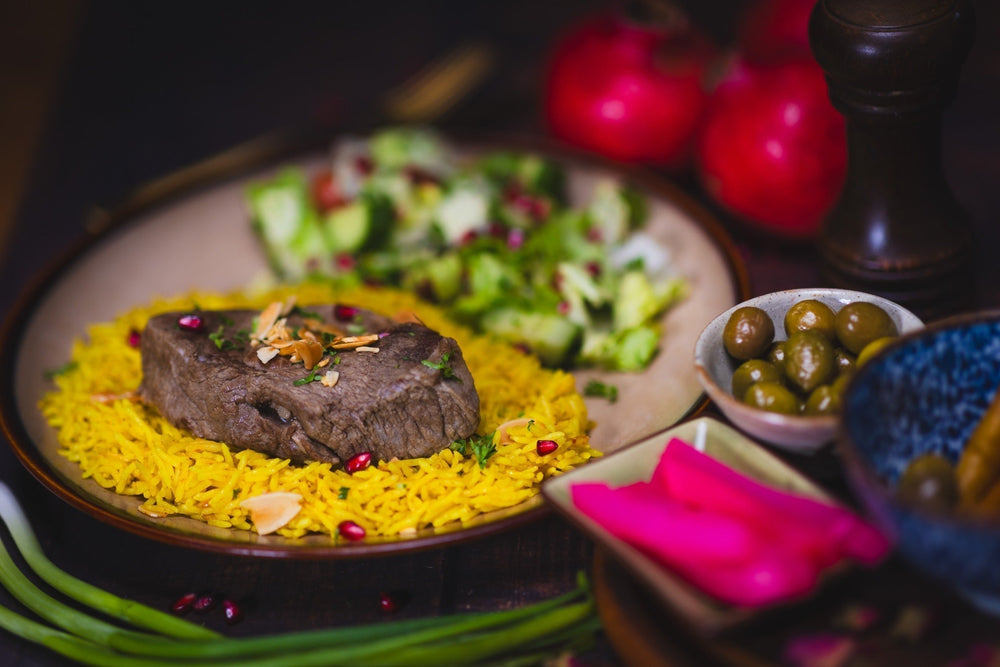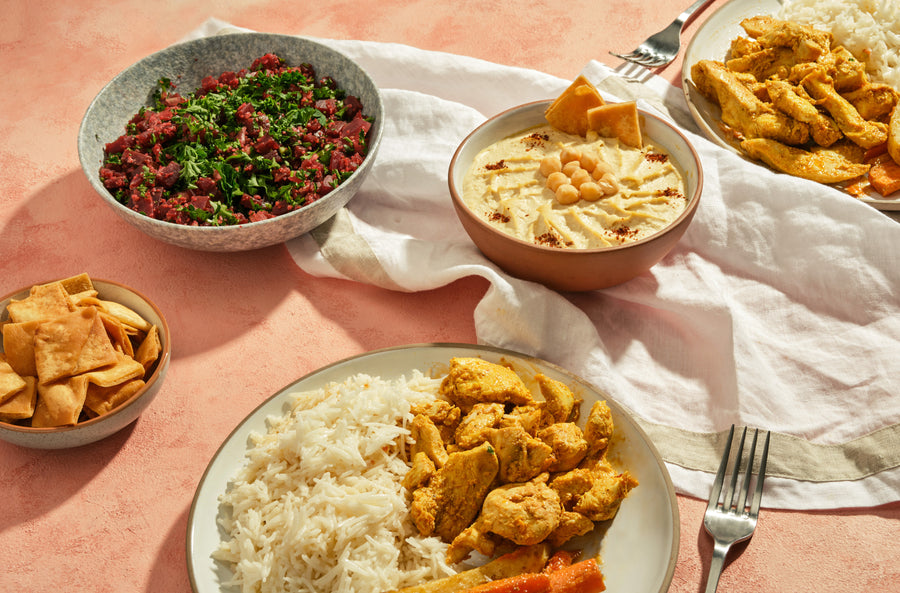Everything about the Rich Flavors and Traditions of Syrian Food: A Culinary Trip
Syrian food provides an unique blend of flavors and practices that mirror its abundant social history. With staple ingredients like olive oil and garlic, along with a selection of seasonings, the dishes are both diverse and inviting. From the intricate preparation of kibbeh to the pleasant attraction of baklava, each facet of this culinary landscape reveals much deeper tales. As one explores the essence of these flavors, a better understanding of common dining and celebration arises.
The Essence of Syrian Ingredients
The essence of Syrian active ingredients depends on their rich variety and ingrained social value. Influenced by the nation's varied geography and history, Syrian cuisine includes a vast range of seasonings, herbs, and fresh fruit and vegetables. Staples such as olive oil, garlic, and lemon supply a foundation, while flavors like sumac, cumin, and coriander include depth and intricacy to dishes.The use of fresh natural herbs, consisting of parsley and mint, highlights the relevance of seasonal components. Additionally, the area's abundant dirt returns a wealth of vegetables and fruits, such as tomatoes, pomegranates, and eggplants, which are important to many recipes. Grains like bulgur and rice create the base of numerous dishes, underscoring the value of these ingredients in Syrian culture. This mix of tastes shows not simply a culinary custom but additionally a tapestry of historic influences, making Syrian components vital to comprehending its food's vibrant character.

Iconic Cuisines of Syrian Food
Syrian cuisine is renowned for its iconic meals that showcase a rich tapestry of textures and flavors. Typical meze plates provide a range of little recipes that tantalize the taste, while hearty main dishes give gratifying focal points for meals (Afternoon Tea Vancouver). To finish the experience, a choice of savory desserts adds a sweet note to the culinary trip
Conventional Meze Plates

Hearty Key Courses
Hearty main programs function as the centerpiece of Syrian eating, showcasing a mix of flavors that mirror the country's abundant cooking traditions. Dishes such as kebab hindi, featuring seasoned lamb skewers, and the celebrated mujaddara, a comforting mix of lentils and rice, highlight making use of fresh components and aromatic flavors. Another staple is the legendary kibbeh, made from bulgur wheat and minced meat, usually served in various types, consisting of baked, fried, or raw. Furthermore, the flavors of the land come to life in dishes like packed veggies, referred to as mahshi, which are full of rice, meat, and herbs. These main dishes not only satisfy appetite however also tell stories of household celebrations and social heritage.
Delicious Treats Option
A wonderful selection of treats specifies the wonderful side of Syrian food, supplying a tantalizing end to any meal. Among one of the most celebrated confections are baklava, fragile layers of phyllo bread filled with nuts and drenched in syrup, and maamoul, shortbread-like cookies commonly packed with days or nuts. Knafeh, an abundant dessert made from slim noodle-like bread saturated in syrup and layered with cheese, is a popular choice, particularly during festive celebrations. Additionally, the wonderful and great smelling rice dessert, referred to as roz bil laban, supplies a reassuring coating. These scrumptious treats not just showcase the area's culinary knowledge but also reflect the social heritage of Syria, making them treasured treats in both homes and dining establishments alike.
Conventional Cooking Strategies
Although modern-day conveniences have actually influenced many cooking methods, typical cooking techniques continue to be crucial to Syrian cuisine. These methods often highlight the use of fresh, seasonal ingredients and concentrate on slow cooking to create abundant flavors. Strategies such as grilling, braising, and stewing are widespread, allowing the all-natural tastes of the ingredients to beam through.One noteworthy strategy is the prep work of kibbeh, a recipe made from carefully ground meat and bulgur. It requires skillful hand-rolling into different shapes and can be baked, fried, or offered raw. Additionally, the art of making bread, especially pita, is central to numerous meals, commonly cooked in a typical stone oven.Preservation methods like pickling and fermenting this website likewise play a vital role, improving the variety of tastes found in Syrian dishes. These methods not only show the region's farming heritage yet also foster a solid sense of community through shared culinary techniques.

The Duty of Spices in Flavor
Spices function as the heart beat of Syrian food, instilling dishes with intricate flavors and fragrant deepness. Each spice plays a crucial duty, contributing not only to taste yet also to the cultural heritage of the region. Commonly utilized flavors consist of sumac, cumin, and coriander, each offering an one-of-a-kind profile that elevates standard dishes. As an example, cumin provides warmth and earthiness, while sumac adds a tasty brightness, enhancing the overall dish.Syrian chefs commonly blend flavors to create unified profiles, showing the elaborate equilibrium of flavors that define the food. Making use of seasonings is not just for flavoring; it also serves to preserve food and enhance its nutritional worth. This thoughtful unification highlights a deep understanding of the cookeries, where spices end up being crucial authors, sharing the abundant history and diverse influences that identify Syrian gastronomy. Inevitably, flavors are important in crafting remarkable and authentic Syrian dishes.
Congratulatory Meals and Festive Personalizeds
Commemorative dishes in Syrian cuisine are marked by conventional feast meals that mirror the nation's rich culinary heritage. Special celebrations frequently involve special routines that boost the public experience of dining. These personalizeds not only recognize the significance of the occasions but likewise enhance familial browse around this site and social bonds.
Standard Feast Cuisines
When families collect to commemorate significant events in Syria, typical feast recipes take facility phase, showcasing the rich cooking heritage of the region. These events typically include vibrant platters of mezze, including hummus, baba ghanoush, and tabbouleh, which offer as delightful starters. The main dish normally highlights lamb or hen, marinated and cooked to excellence, frequently come with by great smelling rice pilaf or bulgur. Among the most cherished recipes is maqlooba, a layered rice meal with veggies and meat, turned inverted prior to offering. Sugary foods additionally play an essential duty, with baklava and knafeh offering a wonderful coating to the meal. Each dish not only delights the taste buds yet likewise mirrors the deep-rooted customs and public spirit of Syrian culture.
Unique Occasion Routines
Unique celebrations in Syria are marked by abundant routines that intertwine food and festivity, mirroring the social importance of common gatherings. Commemorative meals frequently include standard recipes such as kibbeh, tabbouleh, and numerous smoked meats, prepared with treatment and shared amongst family members and pals. During religious vacations like Eid al-Fitr and Eid al-Adha, families come together to prepare special sugary foods like maamoul, representing unity and happiness. Wedding celebrations are particularly intricate, including numerous training courses and vivid display screens of friendliness. These occasions are not just concerning food; they incorporate narration, dancing, and music, reinforcing social bonds and cultural heritage. With these rituals, Syrians celebrate life's landmarks, making certain traditions are passed down through generations, enriching their cooking landscape.
The Relevance of Sharing and Area
Sharing meals is an essential element of Syrian society, mirroring the ingrained worths of area and link. In Syria, food is not just food however a means of bringing people with each other. Friends and families gather around the table to delight in traditional recipes, promoting bonds and creating enduring memories. This communal eating experience highlights hospitality, where hosts go to great lengths to assure every visitor really feels welcomed and nourished.The act of sharing food additionally represents generosity and solidarity, enhancing social connections within communities and larger communities. Throughout gatherings, it is typical for people to serve each various other, showcasing a spirit of togetherness that transcends individuality. Events, whether big or tiny, are frequently marked by the sharing of meals, where varied flavors and meals integrated, reflecting the rich tapestry of Syrian society. Accordingly, the value of sharing and area in Syrian food is not only a culinary practice however an essential social technique.
A Culinary Expedition of Syrian Desserts
Although typically overshadowed by mouthwatering dishes, Syrian sugary foods hold a valued place in the country's culinary heritage. These confections mirror the region's abundant background, mixing flavors and strategies from various cultures. Standard desserts like baklava, with its layers of phyllo pastry, nuts, and honey syrup, showcase the artistry associated with Syrian food preparation. Ma'amoul, a shortbread-like cookie loaded with dates or nuts, is often gotten ready for festive occasions, signifying friendliness and celebration.Another cherished wonderful is Knafeh, a pastry taken in syrup and split with cheese or cream, offering a fascinating comparison of appearances. Syrians likewise delight in a variety of fruit syrups and maintains, usually offered with tea or as part visit the website of a bigger spread throughout events. These sweets not just satisfy the palate yet additionally offer as a bridge between generations, maintaining the practices and tales of Syrian culture through each scrumptious bite
Frequently Asked Questions
What Are the Wellness Perks of Typical Syrian Foods?
The wellness advantages of traditional Syrian foods consist of rich nutrients from fresh veggies, vegetables, and whole grains. These ingredients advertise heart health and wellness, improve digestion, and supply essential vitamins, adding to general wellness and a balanced diet.
Just How Has Syrian Cuisine Advanced Over the Years?
Syrian cuisine has actually evolved significantly, affected by historical profession paths, cultural exchanges, and local schedule of ingredients. Typical meals have incorporated modern-day flavors and methods while maintaining their abundant heritage, showing a diverse cooking landscape.
Exist Vegetarian or Vegan Options in Syrian Cuisine?
Syrian cuisine supplies countless vegan and vegan alternatives, featuring meals like falafel, tabbouleh, and packed grape fallen leaves. These meals highlight the area's abundant agricultural heritage, showcasing fresh veggies, grains, and fragrant spices in vibrant combinations.
What Beverages Set Well With Syrian Recipes?
When taking into consideration drinks that match Syrian recipes, one may find that mint ayran, pomegranate, and tea juice enhance the meal's tastes. Furthermore, merlot frequently pairs well with the spices generally discovered in these cuisines.
Exactly How Can I Recreate Syrian Meals in the house?
To recreate Syrian dishes in the house, one should explore genuine recipes, gather standard components, and use food preparation methods distinct to the food. Try out seasonings and discussion also boosts the general dining experience. Syrian food is renowned for its legendary recipes that display an abundant tapestry of appearances and tastes. Spices offer as the heart beat of Syrian food, instilling dishes with complicated tastes and fragrant depth. Celebratory dishes in Syrian food are marked by standard feast dishes that reflect the country's rich cooking heritage. Parties, whether small or big, are often marked by the sharing of meals, where varied flavors and dishes come together, reflecting the rich tapestry of Syrian society. Syrian food offers countless vegetarian and vegan options, featuring dishes like falafel, tabbouleh, and packed grape fallen leaves.